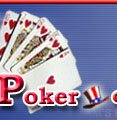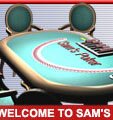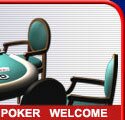|
How to Play 5 Card Omaha Hi Lo
5-Card Omaha Hi-Lo is probably the most popular home game in the United States today. The extra hole card you receive in this variation adds even more excitement to this game. If you like games full of jammed pots, then this is your game. The only difference between regular 4-card and the 5-card variation is the number of hole cards each player gets. Other than that, the rules are identical.
Omaha Hi-Lo is a community card game. All players share the five community cards turned face up in the middle of the table. This aspect of shared cards creates many exciting possibilities since many times the winner of the hand is determined not by the actual pairs that you have made with your hand, but by the kicker (next highest value card) that you hold when the other card has made a pair. Position is very important in this as well as in all flop games, since when you have the button (becoming the theoretical dealer), you are last to act on every betting round. Large amounts of action before and after the flop are created in Omaha since many pots are jammed (raised and reraised) by one player with high cards going for the high end of the pot and another player going for low end of pot, each betting on the relative strength that they place on these particular hands.
RULES AND ORDER OF BETTING ACTION FOR 5-CARD OMAHA HI-LO
| The dealer deals each player two hole cards face-down. Each player can see only his own cards. |
 |
| First betting round |
 |
| The dealer spreads three community cards face up on the table. These three cards are commonly called "the flop". |
 |
| Second betting round |
 |
| The dealer turns over a fourth card face up on the table. This fourth card is commonly called "the turn". |
 |
| Third betting round |
 |
| The dealer turns over one final community card face up on the table. This fifth and final card is commonly called "the river". |
 |
| Fourth and final betting round |
| Players show their hands. This is commonly called "the showdown". |
Remember, poker is a game of the best five cards. At this point, the best hand wins the pot. At the showdown in Omaha, players must use exactly two hole cards and three community cards. Since you have a total of five hole cards, it is ok to use two hole cards for your high hand and two different hole cards for your low hand. (Be careful as this part of Omaha confuses many hold’em players.)
BETTING
There are four betting rounds for each game in Omaha Hi-Lo. Each bet in the first two rounds of betting is set at the lower limit of the stakes structure. For example in a $5/$10 game, all bets and raises are $5 for the first two rounds (preflop and flop). The last two rounds of betting (turn and river) are set at the higher limit of the stakes structure. In a $5/$10 game, all bets and raises are $10 for the last two rounds.
One bet plus three raises (four total bets) are the maximum amount of bets allowed per betting round. This would consist of (1) a bet, (2) a raise, (3) a re-raise, and (4) another re-raise (also known as “a cap”). The term cap is used to describe the third raise in a round since betting is then capped and cannot be raised anymore. Once a player has made the third raise (thereby capping the pot) then players will have only the option of calling or folding. Check raising is allowed in all games.
DEALER BUTTON
In order to designate which player is the theoretical dealer in Omaha games, a round disk is used. This disk is called the dealer button or simply "the button".
When the first hand is dealt in Omaha, the button is always given to the player that is to the immediate right of the dealer chip rack. In tournaments, however, one card is dealt to each player and the button is given to the player with the highest card. After each hand is completed, the button moves clockwise to the next active player and this player will be considered to be the dealer, and will act on his hand last on each betting round for that game. It is a big advantage to act last in Omaha and by moving the button, each player gets to take a turn at having this advantage. When it’s your turn for the button, you are said to be “playing the button.”
SMALL AND BIG BLINDS
The player to the left of the button is first to receive a card and is required to post a small blind. The small blind is equal to half the lower limit bet rounded down to the nearest dollar. The player to the left of the small blind is required to post the big blind. The big blind is equal to the lower limit bet. These bets are referred to as blinds because players must post them before the dealer deals any cards to the players. You are at a disadvantage when you its your turn to post a blind, since you’re actually putting money out on table before you see your cards, whereas other players have a chance to see their cards before they decide to invest any money in that hand or not. As the button moves around, everyone gets a turn to be a blind. These blinds are similar to the ante that is required in other games such as 7-Card Stud.
Both the small and the big blinds are considered live bets. They have the option of checking, calling, raising or folding when the betting action comes back around to their position. After the flop and after each subsequent betting round, the first active player to the left of the button is the first to act.
When players first sit down to play, they will be required to post the equivalent of the big blind only once or they have the option to "sit out" until it is their natural turn to post the big blind. This rule is in place to ensure game fairness to all players. The rule prevents the possibility of players entering games in late position and then leaving before they are required to post the big blind. When you first enter a game it is always a good idea to either wait for your turn for the big blind or post your blind immediately after button passes you. Using either one of these ways, you’ll get the most bang for your buck.
HOW THE LOW HAND IS DETERMINED
A low hand must be five unpaired cards (with the highest card no greater than an 8). A, 2, 3, 4, 5 is the best low hand (as straights and flushes do not apply to low hands). This is also known as the bicycle and is the nut (best possible) low.
The winning Low Hand (8 or better) is first decided by the player with the lowest high card. Upon a tie with the high card, the hand goes to the player with the next lowest high card. If the two highest cards are tied, then you move on to the third highest card, etc. Any hand of five cards that contains card values of 9 or higher cannot qualify as a low hand.
Omaha Hi/Lo is a very exciting game as players try to get a lock (sure-winner) on one side of the pot and gamble on drawing to the other side of the pot. An example would be if you have As, 2s, 3d, Kc and the flop is 7s, 5s, Kd. The designation As,2s means Ace (spades) and Deuce (spades). Here you have the very best hand for low and a nut ace high flush draw plus pair of kings for high. This is the very type of pot that players get excited and jam (place many bets) in the pot, along with many other combinations that are possible in this game.
THE WINNER
At the end of the final (fourth round, called the river) round of betting, the remaining live players show their hole cards and the highest value hand wins the high half of the pot. The player with best qualifying low hand wins the low half of the pot. In order for a qualifying low hand to be possible, there must be at least three non-pairing community cards (out of the five) that have a value of eight or less. If there is no qualifying low hand, then the high hand wins the entire pot (100%). When one player wins the entire pot, he is said to have scooped the pot. Keep in mind it is possible to split two or more ways either the high or the low parts of the pot.
Click here to download our multiplayer online poker games and tournaments. Play Texas Hold'em and other internet poker games online at Sams Poker. Blackjack Tournaments Online found exclusively at Sams Poker. Also, enjoy a friendly game of Gin Rummy at our internet poker room. Gin Rummy tournaments online are coming soon! Press here to join our poker party today! To begin our free poker software download now you can also press the "play now" button bellow! Don't forget to register for the Sams Poker newsletter. Weekly newsletters are sent out to subscribers with the best online poker bonuses on the net. See you at the poker tables!
|












